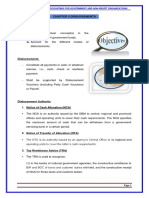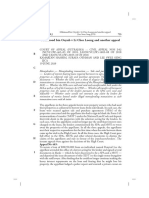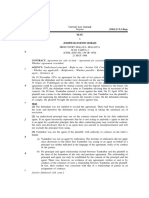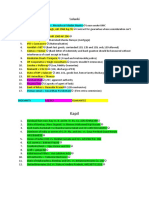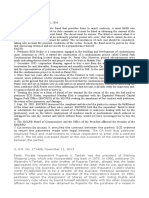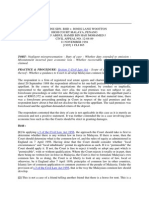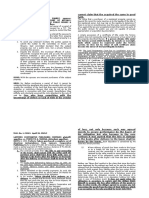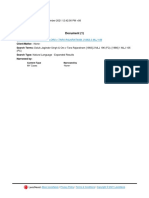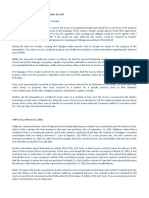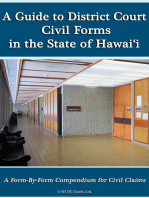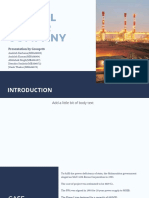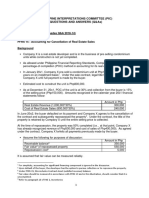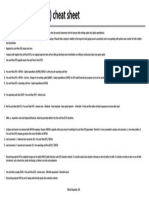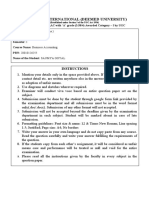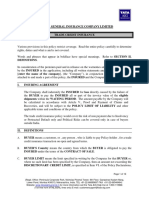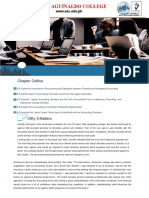Shim Vui Geh
Uploaded by
Prayveen Raj SchwarzeneggerShim Vui Geh
Uploaded by
Prayveen Raj SchwarzeneggerShim Vui Geh
392 [2024] 1 MLRA
v. Dayang Masturah Sahari & Another Appeal
SHIM VUI GEH
v.
DAYANG MASTURAH SAHARI & ANOTHER APPEAL
Court of Appeal, Putrajaya
Lee Swee Seng, Supang Lian, Azimah Omar JJCA
[Civil Appeal Nos: S-01(NCVC)(W)-139-03-2022 & S-01(NCVC)(W)-140-03-
2022]
17 October 2023
Contract: Breach — Loan agreement — Default in repayment — Properties put
up as security by respondents (borrowers) transferred and registered in appellant’s
(lender) name upon default in repayment of loan — Appeal against finding that loan
transactions were illegal moneylending transactions and transfer of properties back to
borrowers — Whether loan transactions were friendly loan transactions — Whether
lender could realise security for loans by way of outright transfer of properties upon
default by borrowers in repayment — Whether transfer and registration of properties
in lender’s name indefeasible — Whether counterclaim by lender for torts of injurious
falsehood and abuse of process not made out — Whether borrowers could deny being
bound by what they had signed
Dayang Masturah Sahari (Dayang) i.e. the respondent in Civil Appeal No.
S-01(NCvC)(W)-139-03-2022, was the plaintiff in High Court Suit No. SDK-
22NCvC-1/1-2020 (Dayang’s suit) and the mother of Mohd Harun Indra Pg
Elias (Harun) who was the respondent in Civil Appeal No. S-01(NCvC)(W)-
140-03-2022 and the plaintiff in High Suit No. SDK-22NCvC-26/12-2019
(Harun’s suit). Dayang had on behalf of Harun obtained loans from the
appellant in both appeals, Shim Vui Geh (Sim), who was the 1st defendant
in Dayang’s suit and Harun’s suit. Both Dayang and Harun had executed
a deed of acknowledgment and undertaking to repay (deed) the said loans.
As security for the said loans, three properties belonging to Dayang and one
belonging to Harun were put up, and an option to purchase, sale and purchase
agreements and corresponding memorandum of transfer (collectively the
security documents) were executed by Dayang and Harun. Upon default in
the repayment of the loans, Shim exercised the respective options to purchase,
and sale and purchase agreements to effect the registration of the properties in
his name.
By way of their respective suits in the Court below, Dayang and Harun sought
a declaration that the loans as evidenced by their respective deed were null
and void as the loan transactions were illegal moneylending transactions.
Dayang and Harun also sought an order that the security documents were null
and void and for the properties to be transferred back to them respectively.
Shim in turn counterclaimed for a declaration that he was the lawful and valid
registered proprietor, arrears of rental of the said properties, vacant possession
as well as damages for the tort of injurious falsehood and abuse of process.
Shim Vui Geh
[2024] 1 MLRA 393
v. Dayang Masturah Sahari & Another Appeal
The High Court, in finding in favour for Dayang and Harun, held that the
interest of 1.5% per month/18% per annum sought to be charged after the
payment period was over, rendered the transactions unlawful moneylending
transactions; that the loans were therefore null, void and unenforceable under
ss 15 and 17A of the Moneylenders Act 1951 (MA 1951); thus ordered the
transfer of the four properties back to Dayang and Harun respectively; and
dismissed the counterclaim.
Hence the instant appeals by Shim. Shim argued inter alia that he had merely
loaned the monies to Harun who was a friend and business partner in need and
that although interest was agreed at 1.5% per month upon default in repayment,
none was imposed on the lands transferred to him in repayment of the loans,
thus rebutting any presumption of illegal moneylending. Dayang and Harun
however argued that the presumption of moneylending had not been rebutted;
that Shim did not have a license for moneylending; and that the transactions
were illegal, void and unenforceable. It was also contended that the High Court
had not erred in ordering the transfer of the properties back to them as there
was no right of set off under the law and that as the purchase price was never
paid, the transfer to Shim ought to be set aside. Dayang also contended that she
did not understand English and had signed the deeds without knowing what
they were.
Held (allowing the appeals in part; ordered accordingly):
(1) Notwithstanding that Dayang may not have physically received from Shim
loans meant for her son, Dayang was bound by what she had signed, more
so, given the fact that the amount owing as stated in the statement of agreed
facts filed in the High Court, was agreed to by her. Likewise, Harun could not
resile from what he had agreed to. Parties who had signed documents could
not wriggle out of what they had signed, especially if it was signed before a
solicitor, unless it was a case of misrepresentation, undue influence or fraud.
In the circumstances, Dayang and Harun could not deny that they were bound
by what they signed. (paras 26, 27, 28, 31, 33 & 39)
(2) It was undisputed that Shim had not made any earlier demand on the four
loan transactions nor was there any interest element for the agreed period
of repayment. The interest of 1.5% per month was chargeable only after the
period of repayment of the loan. (paras 30 & 52)
(3) In the case of a friendly loan, the lender should not be made to suffer greater
loss in trying to help a friend or someone in need and to face the uncertainty
of not being able to recover the loan, and the risk of non-recovery and yet not
being able to charge the costs of funds which the lender would have to bear
or conversely put the money to use profitably, or even by earning interest by
putting it in fixed deposit with a bank. In such a situation of trying to help a
person in need, the law did not require one to be so selfless and sacrificial so as
not to be able to charge a reasonable amount of interest upon default to cover
the lender’s loss or the foregoing of his gain. (para 53)
Shim Vui Geh
394 [2024] 1 MLRA
v. Dayang Masturah Sahari & Another Appeal
(4) In the absence of any evidence from Dayang and Harun to support any
allegations of a system, regularity, pattern or continuity where Shim’s lending
was concerned other than to themselves, the presumption under s 10OA of
the MA 1951 had been rebutted. In the premises, the High Court had erred in
regarding Sim’s lending to Dayang and Harun as moneylending transactions.
(paras 57 & 68)
(5) The respective claim by Dayang and Harun in the Court below came within
the meaning of ‘any proceedings against any person’ in s 10OA of the MA
1951, thus entitling them to rely on the presumption that Shim was carrying
on the business of moneylending. Be that as it may, the said presumption was
rebutted when the evidence adduced by Shim showed that he had not lent to
others, was not challenged. (paras 65 & 67)
(6) By virtue of reg 10(2) of the Moneylenders (Control and Licensing)
Regulations 2003 (“the Regulations”), any agreement for moneylending not
in compliance with the prescribed form in Schedule K, would be void, of no
effect and unenforceable. In this regard, a sale and purchase agreement was not
a proper moneylending agreement in compliance with Schedule K. (para 101)
(7) A lender of a friendly loan could not create for himself a form of security
in an outright transfer of the land that the borrower had put up as security. It
would be contrary to public policy to allow a mischief sought to be remedied
by a statutory provision to be defeated on the basis of freedom of contract.
(para 102)
(8) On the facts, the transfers and registration of the four properties in Shim’s
name were not indefeasible as the agreements and memoranda of transfers
were void, and accordingly, the registration of the properties in Shim’s name
was liable to be set aside and the properties reverted to Dayang and Harun.
(paras 103 & 106)
(9) Where there was no prohibition on set off, common law would apply.
Ordinarily, Shim would have been entitled to set off the loans given against
the purchase price of the four properties, if not for the fact that the sale and
purchase agreements and the memoranda of transfer were void, with the result
that no set off was possible. (paras 107 & 114)
(10) On the facts and in the circumstances, the counterclaim by Shim for the
tort of injurious falsehood and the tort of abuse of process that arose allegedly
from the false statements made by Dayang and Harun, could not be sustained.
The fact that the Court may believe certain averments and disbelieve certain
averments of the parties, could not give rise to the tort of injurious falsehood
or the tort of abuse of process. Given that Dayang and Harun had managed to
get their properties back, it could not be said that their respective actions were
an abuse of process. (paras 115-119)
Shim Vui Geh
[2024] 1 MLRA 395
v. Dayang Masturah Sahari & Another Appeal
Case(s) referred to:
Borneo Housing Mortgage Finance Berhad v. Time Engineering Berhad [1996] 1
MLRA 154 (refd)
Chai Then Song v. Malayan United Finance Bhd [1993] 1 MLRH 584 (refd)
Chow Yoong Hong v. Choong Fah Rubber Manufactory [1960] 1 MLRA 447 (refd)
CIMB Bank Bhd v. Anthony Lawrence Bourke & Anor [2019] 1 MLRA 599 (refd)
Citibank Canada v. Confederation Life Insurance Co (1996) CanLII 8269 (refd)
Cubic Electronics Sdn Bhd (In Liquidation) v. Mars Telecommunications Sdn Bhd
[2019] 2 MLRA 83 (refd)
Esmail Sahib v. Noordin [1951] 1 MLRH 541 (refd)
Gan Yook Chin & Anor and Lee Ing Chin & Ors [2004] 2 MLRA 1 (refd)
Global Globe Property (Melawati) Sdn Bhd v. Jangka Prestasi Sdn Bhd [2020] 5
MLRA 140 (refd)
John Lee & Son (Grantham) Ltd And Others v. Railway Executive [1949] 2 All ER
581 (refd)
Kimlin Housing Development Sdn Bhd (Appointed Receiver And Manager)(In
Liquidation) v. Bank Bumiputra (M) Bhd & Ors [1997] 1 MLRA 267 (refd)
Leong Chooi Peng v. Tee Yam [2012] MLRHU 1193 (refd)
Litchfield v. Dreyfus [1906] KB 584 (refd)
Sandhu Singh v. Sellathurai [1955] 1 MLRH 382 (refd)
Sia Hiong Tee & Ors v. Chong Su Kong & Ors [2015] 3 MLRA 652 (refd)
Subramaniam Dhanapakiam v. Ghaanthimathi [1991] 4 MLRH 751 (refd)
Suisse Atlantique Societe D’armement Maritime SA v. NV Rotterdamsche Kolen
Centrale [1966] 2 All ER 61 (refd)
Tan Aik Teck v. Tang Soon Chye [2007] 2 MLRA 58 (refd)
UMW Industries (1985) Sdn Bhd v. Kamaruddin bin Abdullah & Anor [1989] 2
MLRH 19 (refd)
Legislations referred to:
Contracts Act 1950, s 24(b)
Courts of Judicature Act 1964, s 25(2),
Moneylenders Act 1951, ss 2, 10L, 10M(3), 10N(6)(7), 10O(2), 10OA, 10OB,
10OC, 15, 17A
Moneylenders (Amendment) Act 2003 [Act A1193], s 3 - deleted
Moneylenders (Amendment) Act 2011 [Act A1390], s 10OA
Moneylenders (Control and Licensing) Regulations 2003, reg 10(1), (2)
Sabah Land Ordinance, s 88
Sabah Land Rules, G.N. 55 of 1930, rr 14(1)-(20)
Shim Vui Geh
396 [2024] 1 MLRA
v. Dayang Masturah Sahari & Another Appeal
Counsel:
For Civil Appeal No: S-01(NCVC)(W)-139-03-2022
For the appellant: Tsang Hieng Yee; M/s Tsang & Co
For the respondent: Sharatha Masyaroh John Ridwan Lincon; M/s Lincon & Co
For Civil Appeal No: S-01(NCVC)(W)-140-03-2022]
For the appellant: Tsang Hieng Yee; M/s Tsang & Co
For the respondent: Sharatha Masyaroh John Ridwan Lincon; M/s Lincon & Co
JUDGMENT
Lee Swee Seng JCA:
[1] A friend in need is a friend indeed and a wise teacher once said “Give to
the one who asks you and do not turn away from the one who wants to borrow
from you.” Yet money has, on many an occasion, soured and spoilt friendship
as can be seen here in the parties suing each other over the true nature of
money lent, the sum of which is not disputed in the Statement of Agreed Facts
(“SAFs”).
[2] This judgment shall explore whether a lender may charge reasonable
interest upon default to repay by the borrower in a friendly loan or would
the imposition of interest of any amount upon default make the loan an
illegal moneylending transaction. It shall also delve into the interplay of the
presumption of moneylending even though there is only a single transaction
of a loan at interest and the proof of the business of moneylending by a
moneylender.
[3] There is also the related issue of whether a lender may take as “security” for
a loan an option to purchase the lands put up as security for the loan together
with a sale and purchase agreement and a memorandum of transfer duly signed
when the loan was acknowledged to have been taken and upon a default in
payment, to then effect the transfer over from the borrower to the lender. What
then is the effect of such a transfer even if the loan is a friendly loan?
At The High Court
[4] There were 2 Suits heard together in the High Court below. One was
brought by Dayang Mastura Bt Sahari (“Dayang”) in Suit SDK- 22NCvC-1/1-
2020(HC) (“Dayang’s Suit”) and the other by Mohd Harun Indra Bin Pg Elias
(“Harun”) in Suit SDK-22NCvC-26/12-2019(HC) (“Harun’s Suit”); both in
the High Court in Sabah and Sarawak at Sandakan.
[5] Dayang is Harun’s mother and it is not disputed that Harun had asked
his mother to help him to borrow from one Shim Vui Geh (“Shim”), the 1st
defendant in both the Suits. Hence Dayang had furnished her properties as
“security” for the loans.
Shim Vui Geh
[2024] 1 MLRA 397
v. Dayang Masturah Sahari & Another Appeal
[6] The principal defendant is Shim and we should also state at this juncture in
passing that there were the Registrar of Land Titles of Sabah and the Director
of Lands and Survey Department Sabah named as the 2nd and 3rd defendants
respectively in the High Court below for both the Suits. They took no part in
the proceedings and were named only as nominal defendants for the purpose
of effecting a transfer back of the 4 pieces of land back from Shim to Dayang
and Harun.
[7] The plaintiff, in both Suits heard together, had prayed for a declaration that
the loans taken as evidenced in the 3 Acknowledgements of Indebtedness and
Undertaking to Pay in Dayang’s Suit and one in Harun’s Suit are null and void,
being an illegal moneylending transaction.
[8] There were also the consequential prayers that the relevant Options to
Purchase, Sale and Purchase Agreements and Memoranda of Transfer and
indeed the transfer of 3 properties in Dayang’s Suit and one in Harun’s Suit are
null and void and an order that the properties in the lands be transferred back
to the respective plaintiffs.
[9] The defendant on the other hand had counterclaimed for a declaration that
he is the lawful and valid registered proprietor of the 4 properties and for the
arrears of rental on the 4 properties and vacant possession of the same as well
as damages for the tort of injurious falsehood and abuse of process.
[10] The High Court found for both the plaintiffs after having concluded from
the evidence adduced that the interest of 1.5% per month or 18% per annum
sought to be charged after the repayment period was over, made the transactions
an unlawful moneylending transaction and thus the loans are null and void and
unenforceable under s 15 and s 17A of the Moneylenders Act 1951 (“MA
1951”). As for the properties transferred over, there was no right of set off by
applying the loan sums towards the agreed purchase price of the properties
which various loan sums corresponded to the same amount as the purchase
price. That being the case, there was no purchase price paid on the purported
sale of the 4 properties and so these landed properties shall be transferred back
to the respective plaintiffs and registered proprietors of the lands.
[11] The defendant’s counterclaim was correspondingly dismissed. Aggrieved
by the decision of the High Court, the defendant had appealed to the Court of
Appeal.
Before The Court of Appeal
[12] Before us, the plaintiff argued that the moneylending is a friendly loan as
not only were the plaintiff Harun and the defendant Shim, business partners
in a company called Borneo Mulia Sdn Bhd, both being shareholders and
directors, but that Shim had also known Harun’s father and an uncle of Harun
and they have some birds’ nest business together.
Shim Vui Geh
398 [2024] 1 MLRA
v. Dayang Masturah Sahari & Another Appeal
[13] Harun and Shim were not strangers but instead have done business
together for years and so when Harun wanted a loan, Shim as a friend felt
obliged to help with no element of interest charged for the repayment period
of some 6 months from July to December 2017 and interest would only be
chargeable at the rate of 1.5% per month on the amount outstanding thereafter.
[14] Even then, the interest was not imposed at all and the transfer of the 4
pieces of land, 3 belonging to Harun’s mother, Dayang and one belonging to
Harun, were all done for expediency with the agreed purchase price being the
same as the various loan amounts.
[15] Shim contended that both Harun and Dayang knew about this because
some rentals were paid on the lands after the registration into Shim’s name
and it was only when Shim asked for vacant possession after default in rental
payments that Dayang and Harun filed their respective suits to declare the
moneylending transaction as an illegal one and to obtain a declaration that the
transfer of the lands to Shim were illegal, null and void and for the lands to be
transferred back to Dayang and Harun respectively.
[16] Shim argued that there was no evidence of a system of moneylending
to others or a pattern of continuity in such a moneylending transaction and
that he had only lent to a friend and business partner in need. As such, any
presumption of illegal moneylending had been rebutted and though interest
was agreed at 1.5% per month upon default in repayment after 31 December
2016, yet none was imposed on the lands transferred to Shim in repayments
of the loans.
[17] It is not disputed that Harun had wanted more loans and so he had
convinced his mother Dayang to help by “securing” her 3 pieces of land
to Shim for 3 loans amounting to RM1.23 million after the initial loan of
RM1,152,240.00 was “secured” over Harun’s land.
[18] Both Harun and Dayang argued that the presumption of moneylending
had not been rebutted and that even a single transaction may amount to
moneylending such that as Shim does not have a licence for moneylending, the
transaction is illegal, null and void and unenforceable.
[19] They also argued through their Counsel that the learned High Court Judge
had not erred in ordering the transfer of the 4 pieces of land back to them as
there was no right of set off under the law and as the purchase price had not
been paid, the transfer ought to have been set aside as was so ordered by the
High Court with the consequential order of a transfer back of those 4 pieces of
land to Dayang and Harun.
[20] The parties shall be referred to as Shim, Dayang and Harun; Shim being
the principal defendant/appellant and Dayang being the plaintiff in the
Dayang’s Suit and Harun the plaintiff in the Harun’s Suit, both being heard
together in the High Court below.
Shim Vui Geh
[2024] 1 MLRA 399
v. Dayang Masturah Sahari & Another Appeal
[21] Before us too, both appeals of Shim from the decision of the High Court
in Dayang’s Suit and Harun’s Suit were also heard together.
Whether The Borrowers Can Deny Knowing Or Understanding What They
Had Signed With Respect To The Loans Taken
[22] There is nothing wrong in lending to someone in need especially when
the borrower is known to you as a friend. It has often been said that what
is prohibited by the MA 1951 is not moneylending but the business of
moneylending without a licence. As to whether a lender is in the business of
moneylending, that is a question of fact which determination would turn on
the evidence of a system, regularity, continuity or pattern in the lending activity.
[23] Thus, it was said in the context of the English statute on moneylending in
Litchfield v. Dreyfus [1906] KB 584 by Farwell J said (at p 590) as follows:
“...it would be a straining of the language of the Act to hold that a man who
so obliges friends is carrying on the business of a moneylender. The Act was
intended to apply only to persons who are really carrying on the business of
moneylending as a business, not to persons who lend money as an incident of
another business or to a few old friends by way of friendship. The particular
Act was supposed to be required to save the foolish from the extortion of a
certain class of the community who are called moneylenders as an offensive
term. Moneylending is a perfectly respectable form of business. Nobody says
that bankers are rascals because they lend money.”
[24] In the SAFs for Dayang’s Suit in encl 17, the amount of the loans
corresponding to the dates the loans were taken or accepted as having being
taken were admitted in para 1-3 thereof. The following was clearly and
unequivocally admitted as the acknowledgments of loans in three (3) Deeds
of Acknowledgment Indebtedness and Undertaking to Pay dated 26 July 2016
for the sum of RM480,000.00 (“1st Deed”); dated 26 July 2016 for the sum
of RM500,000.00 (“the 2nd Deed”) and dated 9 November 2016 for the sum
of RM250,000.00 (“the 3rd Deed”). She acknowledged being indebted to the
Defendant in the respective sums.
[25] The relevant paras 1 — 3 of the SAFs are reproduced below
“1. Pursuant to a Deed of Acknowledgment of Indebtedness and
Undertaking to Pay dated 26 July 2016 (hereinafter referred to as
“the said 1st Deed”), the Plaintiff acknowledged that the Plaintiff
indebtedness to the 1st Defendant in a sum of Ringgit Malaysia
four hundred and eighty thousand (RM480,000.00) upon the
terms and conditions in the said 1st Deed.
2. Pursuant to a Deed of Acknowledgment of Indebtedness and
Undertaking to Pay dated 26 July 2016 (hereinafter referred to as
“the said 2nd Deed”), the Plaintiff acknowledged that the Plaintiff
indebtedness to the 1st Defendant in a sum of Ringgit Malaysia five
Shim Vui Geh
400 [2024] 1 MLRA
v. Dayang Masturah Sahari & Another Appeal
hundred thousand (RM500,000.00) upon the terms and conditions
in the said 2nd Deed.
3. Pursuant to Deed of Acknowledgment of Indebtedness and
Undertaking to Pay dated 9 November 2016 (hereinafter referred
to as “the said 3rd Deed”), the Plaintiff had acknowledged that
the Plaintiff indebtedness to the 1st Defendant in a sum of Ringgit
Malaysia two hundred and fifty thousand (RM250,000.00) upon
the terms and conditions in the said 3rd Deed.
4. Among the terms and conditions of the said 1st, 2nd and 3rd Deed
were as follows:
(i) The Plaintiff undertake and agree to repay the sum
indebtedness on or before 31st December 2016 or upon
demand by the 1st Defendant in writing, whichever is earlier,
And
(ii) In the event that the Plaintiff defaults, fail or neglect to repay
the said sum indebtedness or any part thereof then the 1st
Defendant shall be entitled to take legal action against the
Plaintiff to recover the sum indebtedness.”
[26] Whilst she had contended that these Deeds were signed by her without
her understanding what they were as she did not understand English, we do
not think in the circumstances of this case, she can say that she is not bound
by what she had signed; and more so in the fact that her solicitors had agreed
to in the SAFs being filed with the High Court below. Whereas in this case, she
could have asked the lawyer in the legal firm that she went to sign the 3 Deeds,
the nature of the documents she was signing, even if she had not asked but was
prepared to sign nevertheless, she is still bound by what she had signed.
[27] It is not every day that she would have gone to a solicitors’ office to sign
documents and even to part with her 3 titles to her properties. Surely if it
had been explained to her, as she said by a lawyer in the law office that the
documents she signed was to secure a loan taken on behalf of her son, Mohd
Harun Indra Bin Pg Elias, she would have asked how much the loan is for.
[28] Whilst she may not have physically received the loans from Shim for the
loans were meant for her son Harun, we cannot now go behind the SAFs in the
High Court where she had unreservedly admitted that the loans of RM1.23m
were taken in total as evidenced in the 3 Deeds.
[29] In Harun’s case, it was a loan of RM1,152,240.00 as evidenced in a Deed
of Acknowledgment and Undertaking to Repay dated 26 July 2016 which he
agreed to repay Shim on or before 31 December 2016 or upon demand by Shim,
whichever is earlier. The SAFs appear in encl 16 in Harun’s Suit as follows:
Shim Vui Geh
[2024] 1 MLRA 401
v. Dayang Masturah Sahari & Another Appeal
“1. Pursuant to a Deed of Acknowledgment of Indebtedness and
Undertaking to Pay dated 26 July 2016, the Plaintiff acknowledged
that the Plaintiff indebtedness to the 1st Defendant in a sum of
Ringgit Malaysia RM1,152,240.00 upon the terms and conditions
in the said Deed.
2. Among the terms and conditions of the said Deed were as follows:
(i) The Plaintiff undertake and agree to repay the sum
indebtedness on or before 31 December 2016 or upon demand
by the 1st Defendant in writing whichever is earlier; and
(ii) In the event that the Plaintiff defaults, fail or neglect to repay
the said sum indebtedness or any part thereof then the 1st
Defendant shall be entitled to take legal action against the
Plaintiff to recover the sum indebtedness.”
[30] The period for repayment of the loan was also stated to be on or before
31 December 2016 or upon demand in writing, whichever is earlier. It is not
disputed that Shim did not make an earlier demand on the 4 loan sums. There
is no interest element for the agreed period of repayment. Interest was stated as
would be charged at the rate of 1.5% per month upon default.
[31] Harun had also testified that he did not receive the said sum but in the
light of the SAFs, we do not think he is permitted to resile from what he had
agreed to. His mother Dayang and him had signed the Payment Vouchers for
their respective loans of RM480,000.00, RM500,000.00, RM250,000.00 with
respect to Dayang and RM1,152,240.00 with respect to Harun. It is not their
pleaded case that transactions and documents supporting them were a sham.
[32] Again, Harun also tried to convince the High Court that more than
signing the documents blank including payment vouchers indicating amounts
duly received by him and Dayang, he did not know what he had signed but that
could hardly be believed from someone like him who had studied in Australia
and have some businesses with Shim in the planting of oil palm on his land in
a joint-venture with Shim. Even if he is not sure as to the ramifications of what
he had signed, surely, he could easily have asked the solicitor attending to him,
PW 3, in the legal firm instructed by Shim to prepare the necessary documents
to protect Shim’s interest.
[33] Parties who have signed a document and more so if it is before a
solicitor, cannot wriggle out of what they have signed unless it is a case of
misrepresentation, undue influence or fraud proved. It would not generally be
accepted if the parties assert that they do not know what they signed or that
they did not read what they signed. Otherwise it would be very easy to disclaim
liability merely by relying on what is essentially a plea of non est factum.
Shim Vui Geh
402 [2024] 1 MLRA
v. Dayang Masturah Sahari & Another Appeal
[34] Both Dayang and Harun had subpoenaed as their witness PW 3, Teressa
Binti Sirri, the lawyer from Messrs Chin Lau Wong & Foo, the solicitors who
prepared the various documents for them to sign. We can believe her testimony
when she confirmed that both Dayang and Harun signed the documents in her
presence in her legal firm and that she had explained in Bahasa Malaysia the
contents of the documents to both of them and that they had understood the
contents before they signed the documents.
[35] Her evidence was not challenged as it was in Shim’s favour and her
evidence as a witness for the plaintiffs, Dayang and Harun, had become the
plaintiffs’ evidence. There is no good reason for us to disbelieve PW 3, an
advocate and solicitor of the High Court of Sabah and Sarawak.
[36] In Chai Then Song v. Malayan United Finance Bhd [1993] 1 MLRH 584,
the appellant contended that he signed the Deed of Guarantee with relevant
particulars left blank which were subsequently filled in. The appellant disputed
the validity of the Deed of Guarantee on the grounds that the fundamental
elements of the formation of a contract have not been fulfilled.
[37] The High Court held at p 587 that:
“A person who chose to be careless, or not bothered to find out the contents,
or not bothered to find out the contents therein, or relied completely upon
others to complete the same, is responsible for his own actions and, he is
prevented from denying the contents therein do not bind him.
[38] Likewise, in UMW Industries (1985) Sdn Bhd v. Kamaruddin bin Abdullah &
Anor [1989] 2 MLRH 19, it was observed as follows:
“As for the 2nd defendant’s intention that he only signed blank guarantee
forms, he has only himself to blame as the plea of non est factum does not work
in favour of a person who has shown himself to be negligent.”
[39] We find that both Dayang and Harun cannot deny that they are bound by
what they sign. The question is whether the law would render what they had
signed as evidencing an illegal moneylending transaction or that whether the
‘security” taken is valid under the law.
Whether The Transactions Are Friendly Loan Transactions Or Illegal
Moneylending Transactions
[40] A “moneylender” is defined under the MA 1951 in s 2 thereof as follows:
“'moneylender’ means any person who carries on or advertises or
announces himself or holds himself out in any way as carrying on
the business of moneylending, whether or not he carries on any other
business.”
[Emphasis Added]
Shim Vui Geh
[2024] 1 MLRA 403
v. Dayang Masturah Sahari & Another Appeal
[41] “Moneylending” is defined in s 2 of the MA 1951 as:
“‘moneylending’ means the lending of money at interest, with or
without security, by a moneylender to a borrower.”
[Emphasis Added]
[42] Generally, a single money lending transaction cannot make one a money
lender. In Chow Yoong Hong v. Choong Fah Rubber Manufactory [1960] 1 MLRA
447, the Privy Council adopted the statement of Thomson J (as he then was)
in Sandhu Singh v. Sellathurai [1955] 1 MLRH 382 on the interpretation of a
moneylender:
“The Court of Appeal likewise dealt only with this question; and in dealing
with it concerned themselves very closely with the true meaning and effect
of s 3 of the Ordinance. This section is not in their Lordships’ opinion in the
circumstances of this case of great significance, but in view of the different
approach by the Judges in the Federation of Malaysia, they think it desirable
to make some comment on it.
Section 3 provides that ‘any person who lends a sum of money in consideration
of a larger sum repaid shall be presumed until the contrary be proved to be a
moneylender’. The effect of this section has been considered by Thomson J (as
he then was) in Sandhu Singh v. Sellathurai [1955] 1 MLRH 382 in a judgment
which their Lordships respectfully approve and adopt. To lend money is not
the same thing as to carry on the business of moneylending. In order to
prove that a man is a moneylender within the meaning of the Ordinance,
it is necessary to show some degree of system and continuity in his
moneylending transactions. If he were left to discharge this burden without
the aid of any presumption, a defendant might frequently be in a difficulty.
He might have had only one or two transactions with the moneylender and
he might find it difficult to obtain evidence about the business done by the
moneylender with other parties. Section 3 enables a defendant to found his
claim on proof of a single loan made to him at interest, it being presumed, in
the absence of rebutting evidence, that there were sufficient other transactions
of a similar sort to amount to carrying on of business.”
[Emphasis Added]
[43] Section 3 of the MA 1951 was deleted by the Moneylenders (Amendment)
Act 2003 [Act A1193] (“MAA 2003”) and so now there is a total absence of
that section that used to read as follows:
“3. Certain persons and firms presumed to be moneylender
Save as excepted in s 2A(1) and (2), any person who lends a sum of money
in consideration of a larger sum being repaid shall be presumed until the
contrary be proved to be a moneylender.”
[Emphasis Added]
[44] Whilst the above was deleted there was a further addition of s 10OA
introduced by the Moneylenders (Amendment) Act 2011 [Act A1390] (“MAA
2011”) that reads:
Shim Vui Geh
404 [2024] 1 MLRA
v. Dayang Masturah Sahari & Another Appeal
“Where in any proceedings against any person, it is alleged that such person
is a moneylender, the proof of a single loan at interest made by such person
shall raise a presumption that such person is carrying on the business of
moneylending, until the contrary is proved.”
[Emphasis Added]
[45] In Leong Chooi Peng v. Tee Yam [2012] MLRHU 1193 at p 19 it was said of
the above s 10OA as follows:
“Being a rebuttable presumption, those cases that deal with the meaning of
“the business of moneylending” as referred to in Muhibbah Teguh’s case (supra)
might well prove relevant again in the future in resolving a once-off friendly
loan transaction with interest.”
[46] The current definition of “moneylender” was brought about by the MAA
2011 which came into force on 15 April 2011 vide P.U.(B) 174/2011.
[47] This is to be contrasted with the old definition of “moneylender”
introduced by the MAA 2003 which came into force on 1 November 2003.
“Moneylender” was defined as meaning:
“any person who lends a sum of money to a borrower in consideration of a
larger sum being repaid to him.”
[48] What is clear here is that Shim and Harun are business partners in an
oil palm business and they are shareholders and directors in the company
incorporated for the purpose of the cultivation and harvesting of oil palm on
Harun’s land. They are clearly not total strangers who only met for the purpose
of a loan. Shim had also known Harun’s father and an uncle of Harun and they
have some birds’ nest business together.
[49] In Harun’s own words in his Witness Statement as PW 1, he had admitted
as follows:
“9. Q: What is your relation with Shim Vui Geh?
A: He is my friend and before today’s matter, in year 2005 we had
entered into the Joint Venture Agreement to cultivate and develop my
land as above under the name of Borneo Mulia Sdn Bhd and I am
one of the directors and shareholder of the company. I had resigned
as director in year 2016. So we know each other for almost 11 years.”
[50] Whilst Harun’s mother, Dayang (PW 2), might not have met or known
Shim before the loan transactions, she was clearly introduced by her son Harun
as Harun had only one piece of land for security of the loan and as he needed
to further secure additional loans, he had asked his mother to help. Shim’s
evidence was that he had met Dayang on those times when he went over to visit
Harun during Hari Raya. In Dayang’s own words in her Witness Statement,
she had stated as a matter of fact as follows:
Shim Vui Geh
[2024] 1 MLRA 405
v. Dayang Masturah Sahari & Another Appeal
“12. Q: Are you saying that you never had dealings with Shim Vui
Geh at all?
A: Sometime in 2016, my son had approached me and asked my
favour to contribute capital because he wanted to run a business,
I informed my son that I had no money but if my son insisted to
run the business, he may lend (sic) money from anyone and used my
properties as security.“?
[51] The observation of the Court of Appeal in Tan Aik Teck v. Tang Soon Chye
[2007] 2 MLRA 58 at p 63 would be relevant here as follows:
“....The defendant contended that from the evidence of the plaintiff himself,
the plaintiff met the defendant about two or three times before the loan was
given and as such it could not be a friendly loan....A friendly loan is opposed
to the normal borrowing from a moneylender or financial institution. A
friendly loan is a loan between two persons based on trust. There may be
an agreement such as an I.O.U. or security pledged to repayment but most
important there will be no interest imposed.
....In my view, a friendly loan is a loan given by the lender to the borrower
based on mutual trust whereby the borrower was to repay the loan amount
within the specified time with no interests charged...”
[Emphasis Added]
[52] From the SAFs, no interest was charged during the period of the loan.
However, interest at the rate of 1.5% per month was chargeable after 31
December 2016 after the period of repayment of the loan. Shim argued that
though it was stated as such, he did not in reality charge any interest even after
Dayang’s and Harun’s default. However, there is a catch there as there was
nothing stated as to the market value of the 4 pieces of land taken as security
for the loans which had been transferred to Shim after the default. More shall
be said about that in our discussion on whether the security for the loans could
be by way of outright transfer documents signed in escrow.
[53] We appreciate that in a case of friendly loan, the lender should not be
made to suffer greater loss in trying to help a friend or someone in need and to
face the uncertainty of not being able to recover the loan and the risk of non-
recovery and yet not being able to charge the costs of funds which the lender
would have to bear or conversely put the money to use profitably or even by
earning interest by putting it in fixed deposit with a bank. In trying to help
someone in need, the law does not require one to be so selfless and sacrificial as
not to be able to charge a reasonable amount of interest upon default to cover
the lender’s loss or the foregoing of his gain.
[54] In Subramaniam Dhanapakiam v. Ghaanthimathi [1991] 4 MLRH 751,
where interest upon default was volunteered by the borrower and paid from
time to time, the Singapore High Court had no problem in allowing judgment
to be entered even upon a summary judgment application as follows:
Shim Vui Geh
406 [2024] 1 MLRA
v. Dayang Masturah Sahari & Another Appeal
“In the present case, the defence was no defence. The loans were friendly
loans between two long-time friends. Interest was not demanded but
accepted when offered. The interest was not exorbitant and varied in
accordance with the generosity of the defendant. The plaintiff did not lend
to all and sundry. On these facts, there was no question of the plaintiff being a
moneylender as defined in the Act. If there had been a trial, the result would
have been the same.”
[Emphasis Added]
[55] Long time ago before most of us were born, Spenser-Wilkinson J in Esmail
Sahib v. Noordin [1951] 1 MLRH 541, observed though in the context of the
difference between the English Act and the then Singapore Ordinance with
respect to Moneylending as follows:
“There is however one important difference between the English law on this
subject and the local law. Section 3 of the Moneylenders Ordinance reads as
follows:
3. Save as excepted in paragraphs (a), (b), (c), (d) and (f) of the definition
of ‘Moneylender’ in s 2, any person who lends money at interest or who
lends a sum of money in consideration of a larger sum being repaid
shall be presumed, until the contrary be proved, to be a moneylender.
Counsel were unable to cite any local authority which could assist me in
determining the effect of this section and I have been in some doubt as to
the extent of the burden of proof cast by this section upon a plaintiff who
has in fact lent money at interest. It is difficult to see how else a plaintiff
can discharge this burden except by himself giving evidence to the effect
that he is not a moneylender and by submitting to cross-examination on
the point.”
[Emphasis Added]
[56] Whilst there is no longer the presence of a s 3 presumption, yet there is a
new s 10OA which is a rebuttable presumption that the proof of a single loan
at interest made by such person shall raise a presumption that such person is
carrying on the business of moneylending. Assuming that interest would cover
interest upon default, Shim was unshaken in cross-examination with respect
to any allegation that he had lent to others at interest. Under the MA 1951,
any person who lends money at interest is presumed to be a moneylender and
becomes an unlicensed moneylender if he does not have a licence under the
MA 1951, rendering the loans unenforceable and irrecoverable.
[57] Harun and Dayang had no evidence to offer on any allegations of a
system, regularity, pattern or continuity where Shim’s lending is concerned
other than to themselves. Thus, the presumption under s 10OA had been more
than rebutted by Shim.
[58] We further state that the interest here is interest charged for the duration
of the loan and that upon default, the Court may allow a reasonable interest to
Shim Vui Geh
[2024] 1 MLRA 407
v. Dayang Masturah Sahari & Another Appeal
cover the costs of the funds for the lender and in any event not exceeding the
5% per annum interest that the Court may award on a monetary claim.
[59] The power of the High Court to grant interest on a debt claimed is found
in s 25(2) of the Courts of Judicature Act 1964 [Act 91] (“CJA”) and para 7 of
the Schedule to the Act. Section 25(2) of CJA states:
“Without prejudice to the generality of subsection (1), the High Court
shall have the additional powers set out in the Schedule: Provided that
all such powers shall be exercised in accordance with any written law
or rules of Court relating to the same.”
[60] Paragraph 7 of the Schedule to the CJA then confers upon the Courts as
follows:
“Power to direct interest to be paid on debts including judgment
debts, or on sums found due on taking accounts between parties, or
on sums found due and unpaid by receivers or other persons liable to
account to the Court.”
[Emphasis Added]
[61] The High Court is also vested with the power and discretion to strike
down the interest charged upon default that exceeds the statutory limit of 8%
per annum for secured loan or 12% per annum for unsecured loan or not to
grant any interest at all if the conduct of the lender has the element of taking
advantage of the borrower in distress and high-handed at that.
[62] We appreciate that there is an argument that s 10OA of the MA 1951
applies only to criminal proceedings and not civil proceedings as it is parked
under PART IV under EVIDENCE and that the sections within it deal with
for example, s 10L on Evidence of accomplice and agent provocateur, s 10M
with Protection of informers and information, s 10N with Admissibility of
statements by accused persons, s 10O on Provisions as to evidence and s 10OA
on Presumption as to the business of moneylending. Then there are s 10OB
on Evidence and records of previous conviction and s 10OC on Diary of
proceedings in investigation.
[63] We are not so persuaded as the legislators have used in some instances
“criminal proceedings” as opposed to “any proceedings”. In s 10L, s 10N(6) and
(7) reference is made to “criminal proceedings” in contradistinction to ss 10M(3),
10O(2) and 10OA where the expression “any proceedings” is used.
[64] Moreover, on the earlier sections in s 10M(1) and (2), reference is made
to “any civil or criminal proceedings”, thus allowing us to conclude that the
legislator was very conscious of the fact of the distinction makes a difference.
[65] Furthermore, the reference to “any proceedings” in s 10M(3) is with
respect to “any proceedings relating to any offence under this Act” and in
Shim Vui Geh
408 [2024] 1 MLRA
v. Dayang Masturah Sahari & Another Appeal
s 10O(2) it is “in any proceedings for an offence under this Act.” When it
comes to s 10OA there is a shift in the language used to that of “in any
proceedings against any person.” As we are aware, in the proceedings in the
High Court below, both Dayang and Harun have a claim against Shim. Their
claims would come within the meaning of “any proceedings against any
person.” They thus qualify to use the presumption that Shim was carrying
on the business of moneylending. Be that as it may, Shim had more than
rebutted the presumption when his evidence that he had not lent to others
had not been challenged.
[66] The relevant sections of the MA 1951 are set out below for ease of
reference:
“10M. Protection of informers and information
(1) Except as hereinafter provided, no complaint as to an offence
under this Act shall be admitted in evidence in any civil or
criminal proceedings, and no witness shall be obliged or
permitted to disclose the name or address of any person who
gave the information, or the substance and nature of the
information received from him, or state any matter which
might lead to his discovery.
(2) If any application, particular, return, account, document
or written statement which is given in evidence or liable to
inspection in any civil or criminal proceedings contains any
entry in which any person who gave the information is named
or described, or which might lead to his discovery, the Court
before which the proceedings are held shall cause all such
entries to be concealed from view or to be obliterated so far as
may be necessary to protect such person from discovery, but
no further.
(3) If in any proceedings relating to any offence under this Act,
the Court, after full inquiry into the case, is of the opinion
that the person who gave the information wilfully made in
his complaint a material statement which he knew or believed
to be false or did not believe to be true, or is of the opinion
that justice cannot be fully done between the parties to the
proceedings without the discovery of the person who gave
the information, the Court may require the production of
the original complaint, if in writing, and permit inquiry and
require full disclosure concerning that person.
10N. Admissibility of statements by accused persons
(6) Where in any criminal proceedings against a person for an
offence under this Act, evidence is given that the accused, on
being informed that he might be prosecuted for it, failed to
Shim Vui Geh
[2024] 1 MLRA 409
v. Dayang Masturah Sahari & Another Appeal
mention any such fact, being a fact which in the circumstances
existing at the time he could reasonably have been expected
to mention when so informed, the Court, in determining
whether the prosecution has made out a prima facie case
against the accused and in determining whether the accused is
guilty of the offence charged, may draw such inferences from
the failure as appear proper; and the failure may, on the basis
of those inferences, be treated as, or as capable of amounting
to, corroboration of any evidence given against the accused in
relation to which the failure is material.
(7) Nothing in subsection (6) shall in any criminal proceedings-
(a) prejudice the admissibility in evidence of the silence or
other reaction of the accused in the face of any thing
said in his presence relating to the offence in respect of
which he is charged, in so far as evidence thereof would
be admissible apart from that subsection; or
(b) be taken to preclude the drawing of any inference from
any silence or other reaction of the accused which could
be drawn from that subsection.
10O. Provisions as to evidence
(2) When in any proceedings for an offence under this Act
it is necessary to prove that a person was, or was not, the
licensee, a certificate purporting to be signed by the Registrar
and certifying that the person was or was not, the licensee,
shall be admissible as evidence and shall constitute prima facie
proof of the facts certified in such certificate, without proof
of the signature or the authority of the Registrar to issue the
certificate.
10OA. Presumption as to the business of moneylending
Where in any proceedings against any person, it is alleged
that such person is a moneylender, the proof of a single loan
at interest made by such person shall raise a presumption that
such person is carrying on the business of moneylending,
until the contrary is proved.”
[Emphasis Added]
[67] On the facts of this case, we find that with or without the aid of the rebuttable
presumption under s 10OA of the MA 1951, Shim had given evidence that he
is not in the business of moneylending, with the corresponding characteristic
element of a system, regularity, pattern or continuity of lending at interest and
Dayang and Harun had not been able to adduce any evidence to contradict
that. He had also given evidence of all the businesses he is involved in as a
Shim Vui Geh
410 [2024] 1 MLRA
v. Dayang Masturah Sahari & Another Appeal
businessman and the licenses for the various businesses including trading,
logging, construction, cement, transportation, fertiliser, cleaning business,
hardware and plantation.
[68] With respect, the learned High Court Judge had erred in finding that the
transactions were moneylending transactions when there was no evidence
of a system, pattern, regularity or continuity of Shim being involved in any
moneylending transactions. We are constrained therefore to disturb this finding
of fact of the learned trial Judge in the High Court, guided as we are by the
dicta of Steve Shim (CJ (Sabah & Sarawak)) in Gan Yook Chin & Anor and Lee
Ing Chin & Ors [2004] 2 MLRA 1 on appellate intervention:
“The Court of Appeal had clearly borne in mind the central feature of
appellate intervention i.e., to determine whether or not the trial Court had
arrived at its decision or finding correctly on the basis of the relevant law and/
or the established evidence. In so doing, the Court of Appeal was perfectly
entitled to examine the process of the evaluation of the evidence by the trial
Court. Clearly, the phrase “insufficient judicial appreciation of evidence”
merely related to such a process.”
Whether The Lender Is Allowed To Take A “Security” For The Loans
By Way Of An Outright Transfer After The Borrowers Have Defaulted In
Payment Of The Loans
[69] At the same time as the Deed of Acknowledgment and Undertaking to
Repay was signed, the borrowers Dayang and Harun were also asked to sign an
Option to Purchase, a Sale and Purchase Agreement and a Memorandum of
Transfer Form under the Sabah Land Ordinance together with the land titles to
the respective properties (collectively referred to as the “security documents”)
being deposited with Shim’s solicitors.
[70] The “security documents” for Harun’s land with respect to Harun’s Suit
relate to a piece of land measuring 58.29 hectares situated at Kg. Suan Lamba,
Sandakan held under CL 075536220.
[71] As for the “security documents” for Dayang’s lands with respect to
Dayang’s Suit are as follows:
“(i) One (1) unit of double storey semi-detached house known
as Lot No 188, Astana Heights, Phase 2A situated at Jalan
Lalang, Off Mile 1 y2, North Road Sandakan held under
Master Title No CL 075145103 (“Lot 188”);
(ii) One (1) unit of double storey semi-detached house known
as Lot No 189, Astana Heights, Phase 2A situated at Jalan
Lalang, Off Mile 1 y2, North Road Sandakan held under
Master Title No CL 075145103 (“Lot 189”) and
(iii) One (1) unit of double storey detached house situated at Mile
1.5, Jalan Utara, Jalan Bunga Botan, Sandakan held under
TL 077515443 (“detached house”).”
Shim Vui Geh
[2024] 1 MLRA 411
v. Dayang Masturah Sahari & Another Appeal
[72] Shim’s lawyer, one Miss Teressa Binti Siri (PW 3) of Messrs Chin Lau
Wong & Foo, who prepared the “security documents”, explained to them that
they were the security documents for the loans in the event that the loans could
not be repaid on time by 31 December 2016. The lawyer, PW 3, was a lawyer
of Shim’s choice and both Harun and his mother Dayang were not separately
represented.
[73] In giving evidence for the plaintiffs Dayang and Harun, PW 3 said
under cross-examination in Answer to Questions 278 and 279 in the Notes of
Proceedings as follows:
“Q 278: Did they acknowledge to you that they understood and agreed to the
contents of the documents?
A: Yes. They understood and agreed to the contents of the documents before
they signed. And I remember for this particular Mohd Harun bin Pg Elias
after I explained when I said “kalau kamu gagal bayar duit ini, dalam tempoh
yang dinyatakan disini iaitu Deed of Indebtedness and Undertaking to pay,
Shim Vui Geh akan melaksanakan hak dia didalam Sale and Purchase
agreement berkaitan dengan tanah kamu iaitu dalam ms 65 Bundle B and
after that he said to me “itu kalau, kan puan?” those are his exact words, I
remember exactly.
Q 279: Did you also explain the same “kalau kamu gagal bayar duit ini, dalam
tempoh yang dinyatakan disini iaitu Deed of Indebtedness and Undertaking
to pay, Shim Vui Geh akan melaksanakan hak dia didalam Sale and Purchase
agreement...” to puan Dayang as well?
A: Yes, I also explained the same.”
[74] Clearly from her explanation which we have no reason to disbelieve, the
documents signed were used as “security documents” to effect a transfer upon
default by Dayang and Harun after 31 December 2016. Thus, the Payment
Vouchers were even written as “being full payment of the said purchase price.”
Both Dayang and Harun would have to trust the solicitor as PW 3 confirmed that
all the documents including the Sale and Purchase Agreements, the Memoranda
of Transfer and payment vouchers were kept in her solicitors’ office.
[75] PW 3 Teressa further explained under cross-examination as follows in
Answer to Question 281:
“Q 281: Can you explain why all these documents were kept in your firm?
A: Because these documents were only be enforced if there is a default on the
part of Encik Mohd Harun bin Pg Elias and Puan Dayang in payment of the
sum due to Shim Vui Geh.
Q 282: Do you agree with me that those documents were only to be dated
if and when Encik Harun and Puan Dayang failed to cancel the sale of the
properties by end of December 2016 and Mr Shim exercised the option to
purchase?
A: Yes, agree.”
Shim Vui Geh
412 [2024] 1 MLRA
v. Dayang Masturah Sahari & Another Appeal
[76] When the loans could not be repaid, the respective Options to Purchase
was exercised, the Sale and Purchase Agreements were dated together with
their corresponding Memoranda of Transfer to effect the registration of the
properties to Shim.
[77] Whilst most of the Deeds of Acknowledgment and Undertaking to Repay
were in July 2016 with one dated 9 November 2016 with respect to the loan
of RM250,000.00 by Dayang, the period for repayment of the loans without
interest was by 31 December 2016. The security documents employed being not
a registered charge, the borrowers would have to trust Shim to honour his word
that the properties would not be transferred to Shim until after 31 December
2016. We note that in the Deeds of Acknowledgment and Undertaking to
Repay, Shim would be at liberty to demand for an earlier repayment which in
any event, did not happen in the 2 appeals before us.
[78] We note that there was no expiry date for the Options to Purchase given
to Shim such that Shim can exercise what is made to look like an Option to
Purchase at any time. Both Dayang and Harun would have to trust Shim that
he would not exercise the Options to Purchase earlier than 31 December 2016.
[79] Under the Sabah Land Ordinance (Cap 68)(“SLO”), security over land is
created by way of a charge. The instrument of charge is in the Memorandum
of Charge in Schedule XV (s 104) of the SLO. It is stated in the Memorandum
of Charge as follows:
“In consideration of the principal sum of ringgit lent to me/us by
(hereinafter called “the chargee(s)”), the receipt of which sum I/we
hereby acknowledge, do hereby, bind myself/ourselves to pay to the
chargee(s) on the day of every month/year commencing on the day
of, 19, the said sum and interest thereon at the rate of per cent per
annum by equal payments of ringgit being the total amount of the
principal sum and interest then due.
In default of payment of the interest or of any part thereof, or of
the principal sum hereby secured, it shall be lawful for the said
chargee(s), after the expiration of one month’s notice served upon
me/us by the. chargee(s) or his/their agent as serving officer, to
obtain an order from the Collector for the sale of the said land in
accordance with the provisions of the Land Ordinance.”
[Emphasis Added]
[80] A security for a loan taken cannot be allowed to be created by way of an
outright transfer in the form of an “Option to Purchase”, a “Sale and Purchase
Agreement” signed and a “Memorandum of Transfer” in Schedule XIII form
to the SLO signed in escrow.
[81] Just as in the case of the National Land Code (“NLC”) in West Malaysia,
the provisions of the SLO are exclusive and exhaustive with respect to the
Shim Vui Geh
[2024] 1 MLRA 413
v. Dayang Masturah Sahari & Another Appeal
remedies available with the necessary safeguards for a borrower being built
into the statutory provisions and protection. See Kimlin Housing Development
Sdn Bhd (Appointed Receiver And Manager)(In Liquidation) v. Bank Bumiputra (M)
Bhd & Ors [1997] 1 MLRA 267, a decision of the Supreme Court.
[82] The Sabah Land Rules (G.N. 55 of 1930), have a whole portion devoted to
“SALE OF LAND BY CHARGEE” from rr 14(1) to (20). These sub-rules are
designed to give the borrowers or chargors the mantle of protection of the law.
There is the notice requirement under Schedule H with respect to “NOTICE
BY CHARGEE IN CASE OF DEFAULT.”
[83] After the expiry of the Notice by the Chargee, the chargee would then
proceed under r 14(2) by way of an “APPLICATION BY CHARGEE FOR
SALE OF LAND” by way of the Form in SCHEDULE I.
[84] The Collector would then subsequently pursuant to r 14(2) give the
chargor a “NOTICE BY COLLECTOR THAT CHARGEE HAS APPLIED
FOR ORDER FOR SALE OF LAND” in Schedule J to show cause why the
application should not be granted.
[85] At the hearing, the Collector under r 14(9) is to determine by order in the
form of Schedule K the amount due under the charge and order the sale of the
land charged. The sale shall be by way of a public auction and the auctioneer
shall be nominated by the Collector under r 14(10).
[86] The Collectors shall also under r 14(11) determine the conditions of sale
and he shall also put a reserve price on the land and cause such public notice to
be given of the sale as he may in the interest of the parties or of either of them
think advisable, and may postpone the sale if he thinks fit.
[87] There also other safeguards are provided as in r 14(12) — (14) with respect
to the chargor’s rights as follows:
“(12) At any time prior to the fall of the hammer, the owner of the land
shall have the right to stop the sale upon payment of the sum due
together with all costs.
(13) The chargee may himself bid at the sale.
(14) No officer employed in the Land Office of the district and no officer
having any duty to perform in connection with any sale under the
Ordinance shall either directly or indirectly bid for, acquire, or
attempt to acquire any interest in property offered at such sale.”
[88] See also a consideration of the safeguards in the case of a security taken
by way of a charge under the NLC in the Court of Appeal case of Global Globe
Property (Melawati) Sdn Bhd v. Jangka Prestasi Sdn Bhd [2020] 5 MLRA 140 para
[151]−[153].
Shim Vui Geh
414 [2024] 1 MLRA
v. Dayang Masturah Sahari & Another Appeal
[89] Whilst there is no express prohibition against taking custody of the title
to the property and having a sale and purchase agreement drawn up and the
Memorandum of Transfer as security for a loan, all to be effected upon default,
yet if such a practice is permitted, it would defeat the purpose of the law. The
safeguards afforded to borrower, with many not having the power to negotiate
the terms of the loan when in dire need of money, would be illusory when such
a borrower has to sign the transfer of his land over to the lender in escrow.
[90] It is another mirage for the lender to say that he is not charging interest
upon default when the land taken as security would normally be of higher
market value than the amount of the loan. This was precisely what Shim was
trying to impress the High Court below in that he did not charge interest at all
even after default after 31 December 2016 and that it was Harun who actually
volunteered to pay the interest on the friendly loan. However, no valuation
report was produced to assuage any concerns of the borrowers that the market
value of the 4 pieces of land are not in excess of the amount borrowed.
[91] There was also evidence before the High Court that Shim could charge
Harun’s land to Public Bank for RM2.8 million and Shim’s explanation was
that he had spent money to grow the oil palm which is ready for harvesting and
also because of his credit-worthiness. That is precisely the problem when an
outright transfer for the amount of the loan is taken. There was no notice of
assessment of stamp duty produced by Shim for the transfer of the properties,
which if produced would indicate the Stamp Duty Office’s valuation of the
properties.
[92] In the unlikely event that the market value is less than the amount of loan
taken, the lender could still claim the shortfall, albeit by suing the borrower.
However, when the market value is more, there is no refund of the amount in
excess to the borrower after applying the auction price paid towards settlement
of the loan sum. Rule 14(17) of the Sabah Land Rules provides as follows:
“(17) The purchase money arising from any such sale shall be applied
firstly in the payment of any rent and fees due to the Government;
secondly in payment of the expenses and costs of, and incidental to,
the notices, summonses and sale; thirdly in payment of the moneys
which may then be due or owing to the chargee; fourthly in payment
of subsequent charges if any in the order of their priority, and the
surplus if any shall be paid to the chargor or other person entitled
thereto.”
[Emphasis Added]
[93] The consideration for such a contract is unlawful as a charge should have
been created over the lands in question and not the sale and purchase agreements
and memoranda of transfer and so these agreements and instruments of
transfer are thus void under s 24(b) of the Contracts Act 1950 [Act 136], in
that, if permitted, would defeat the purpose of the SLO as follows:
Shim Vui Geh
[2024] 1 MLRA 415
v. Dayang Masturah Sahari & Another Appeal
“What considerations and objects are lawful, and what not
24. The consideration or object of an agreement is lawful, unless-
(a) it is forbidden by a law;
(b) it is of such a nature that, if permitted, it would defeat any
law;
(c) it is fraudulent;
(d) it involves or implies injury to the person or property of
another; or
(e) the Court regards it as immoral, or opposed to public policy.
In each of the above cases, the consideration or object of an agreement
is said to be unlawful. Every agreement of which the object or
consideration is unlawful is void.”
[Emphasis Added]
[94] We were given to understand that such a practice is very prevalent and that
the Court should respect the freedom of the parties to contract. We must state
emphatically that no matter how prevalent a practice is, it cannot be lawful if
the consideration if permitted would defeat the purpose of the law designed to
protect the weaker and more vulnerable party.
[95] In Global Globe Property (Melawati) Sdn Bhd v. Jangka Prestasi Sdn Bhd Bhd
(supra) the Court of Appeal observed as follows:
“[152] The device of using a sale and purchase agreement as a security for a
loan is clearly to circumvent the protective provisions of the Moneylenders
Act 1951.
Even if the plaintiff lender is not a moneylender at all, it would be an
aberration to allow such a person to charge interest of RM400,000.00 for a
loan of 3 months when even a licensed moneylender would blush under it. A
person who is not a moneylender cannot under the guise of a friendly loan
exact more onerous terms than what a licensed moneylender is permitted
as that would turn the law upside down.”
[Emphasis Added]
[96] In Global Globe Property (Melawati) Sdn Bhd v. Jangka Prestasi Sdn Bhd Bhd
(supra) the Court of Appeal concluded as follows:
“[154] The transaction is illegal as it is forbidden by the Moneylenders Act
1951 and further if allowed, would defeat the purpose of the law. It would also
be against public policy.”
Shim Vui Geh
416 [2024] 1 MLRA
v. Dayang Masturah Sahari & Another Appeal
[97] As for freedom of contract, we must say it needs to be circumscribed by
the paternal protection of the law especially when there is a clear inequality of
bargaining powers. One can imagine the abuse that would come in its wake if
such a practice is approved by the Court. Licensed moneylenders and bankers
would happily jump onto the bandwagon and in future take a transfer in escrow
and immediately transfer the landed properties upon default and make a huge
profit from a so-called more efficient transaction where there is no need to go
before the Collector.
[98] A borrower in dire financial straits has little freedom of contract for
otherwise they would probably have gone to the banks to borrow. Freedom
of contract implies some choice or room for bargaining which the borrowers
here did not have. See the House of Lords case of Suisse Atlantique Societe
D’armement Maritime SA v. NV Rotterdamsche Kolen Centrale [1966] 2 All ER 61
and our Federal Court case of CIMB Bank Bhd v. Anthony Lawrence Bourke &
Anor [2019] 1 MLRA 599.
[99] It was Denning LJ in John Lee & Son (Grantham) Ltd And Others v. Railway
Executive [1949] 2 All ER 581 who captured the reality of unbridled freedom
of contract as:
“Above all, there is the vigilance of the common law while allowing for
freedom of contract, watches to see that it is not abused.”
[100] Regulation 10(1) of the Moneylenders (Control and Licensing)
Regulations 2003 (“the Regulations”) provides that every agreement for
moneylending transaction with security shall be in the form prescribed in
Schedule K and makes it a criminal offence for non-compliance. Paragraph
(4)(a) of Schedule K further provides that where the security is an immovable
property, the property shall be dealt with as provided for under O 83 of the
Rules Of The High Court 1980 which is now to be read as Rules of Court 2012
with respect to Charge Actions.
[101]Regulation 10(2) of the Regulations declares as void and of no effect
and unenforceable any agreement for moneylending not in compliance with
the prescribed form and in this case Schedule K and includes addition to the
prescribed form. A Sale and Purchase Agreement is not a proper moneylending
agreement in compliance with Schedule K.
[102] A lender of a friendly loan cannot create for himself a form of security
in an outright transfer of the land of the borrower put up as security when even
licensed moneylenders and the banks cannot do that. It would be contrary
to public policy to allow a mischief sought to be remedied by a statutory
provision to be defeated on the basis of freedom of contract. See para [54]
of the Federal Court case of Cubic Electronics Sdn Bhd (In Liquidation) v. Mars
Telecommunications Sdn Bhd [2019] 2 MLRA 83.
Shim Vui Geh
[2024] 1 MLRA 417
v. Dayang Masturah Sahari & Another Appeal
Whether The Transfer Of Lands To The Lender And Duly Registered In His
Name Is Liable To Be Set Aside
[103] The 4 pieces of land having been transferred under a void agreement
and instrument are liable to be set aside. In the Federal Court case of Borneo
Housing Mortgage Finance Berhad v. Time Engineering Berhad [1996] 1 MLRA 154
at p 158, Edgar Joseph Jr FCJ explained as follows when dealing with the SLO:
“The preliminary point we should like to deal with is: whether the system of
land tenure in Sabah is based upon the Torrens registration system?
Nowhere in the Land Ordinance is there any provision conferring
indefeasibility of title to or interests in land which is a feature of central
importance to the Torrens system of land registration. This is to be
contrasted with the position in Peninsular Malaysia and Sarawak, where
there are express provisions conferring such indefeasibility. (See ss 92(1)
and s 340 of the National Land Code and s 131 of the Sarawak Land Code
(Cap 81) respectively.) Moreover, in Sabah, unlike Peninsular Malaysia and
Sarawak, in appropriate circumstances the doctrine of adverse possession
may be invoked against private owners of land. (See s 6 of the Sabah Land
Ordinance (Cap 68) which merely bars any claim to any right, title or interest
in state land only based on adverse possession thereof).
.......
Similarly, in the earlier case of Lin Nyuk Chan v. Wong Sz Tsin [1964] 1 MLRA
832, the old Federal Court, which comprised Thomson LP, Wee Chong Jin
CJ (Singapore) and Wylie CJ (Borneo), at a time when our apex Court was
still the Privy Council, expressed the view that the Land Ordinance provides
for a modified Torrens system of land registration....”
[Emphasis Added]
[104] Section 88 of the SLO is often relied on to support the argument that
upon registration the title of the registered proprietor is indefeasible. It reads:
“No new title and no dealing with, claim to or interest in any
land except, land still held under native customary tenure without
documentary title shall be valid until it has been registered in
accordance with the provision of this Part.”
[Emphasis Added]
[105] The more recent Federal Court case of Sia Hiong Tee & Ors v. Chong Su
Kong & Ors [2015] 3 MLRA 652 has reiterated as follows:
“[29] Section 88 of the SLO on the other hand does not incorporate the
concept of indefeasibility of title as found in s 340 of the NLC...
.....
Shim Vui Geh
418 [2024] 1 MLRA
v. Dayang Masturah Sahari & Another Appeal
[30] From the plain reading of s 88 of the SLO, we find there exists a lacuna
in this provision when compared with s 340 of the NLC which embodies the
concept of indefeasibility of title. Registration under the SLO does not confer
indefeasibility of title, deferred or immediate. We are of the view that in the
absence of statutory intervention in the like of the proviso to s 340(3), there is
no protection afforded to the bona fide purchaser for value without notice such
as the appellants in the present case. Therefore, with respect, we differ from
the view expressed by Richard Malanjum J in Ngui Yu Thau v. Wong Mu Khyun
& Ors, at p 289 where he stated: ‘Thus in Sabah with specific reference to land,
the principle as enunciated by the Federal Court in Adorna Properties Sdn Bhd
applies notwithstanding the lacuna in the Ordinance. In other words no one
derives good title, right or interest from or through a forged instrument unless
he satisfied the doctrine of bona fide purchaser for value and without notice.’
[31] We are of the view that s 88 of the SLO must be considered on its own
without being unnecessarily influenced by the provisions of the NLC because
they are poles apart. Section 88 of the SLO merely deals with the registration
of new title, dealing with claim to or interest in any land, other than land held
under native customary tenure without documentary title. It requires such
title or dealing, etc. to be registered for it to be valid under the SLO. In other
words, it does not deal with the issue of defeasibility or indefeasibility of title
as contained in s 340 of the NLC.
[32] The fact that the names of the appellants found their way on the register
of title does not automatically confer on the appellants an indefeasible title.
In other words, it is open to enquiry as to how the appellants got themselves
registered as owners of the land. That was precisely what the Courts below did
in the present case and came to the conclusion that the appellants could not
get valid title to the land on the ground that the power of attorney which was
used as authority to transfer the land was a forgery. In its judgment, the Court
of Appeal stated:’... in this case that the power of attorney that was used
as authority to transfer the said land to the appellants is a forgery, we agree
with the learned trial Judge that the title of the appellants to the property is
defeasible and that the appellants could not have acquired a valid title to the
said land though the land has been registered in the name of the appellants.’
[33] We agree with the finding of the Courts below that the instrument of
transfer in the present case was an invalid or void instrument of transfer as
it was executed on the authority of a forged power of attorney, therefore, it
could not give rise to a valid title in law and the SLO does not seek to give
validity to such a title even though the appellants were bona fide purchasers
for value without notice. There is nothing in the SLO giving protection to such
purchasers. Such statutory protection must be expressly provided in the SLO
(Gibbs w Messer [1891] AC 248).”
[Emphasis Added]
[106] The transfer of the 4 titles to Shim and duly registered in his name is not
indefeasible as the agreements and memoranda of transfers are void for the
reasons given and thus the registrations have to be set aside and the 4 pieces of
land reverted to the original proprietors in Dayang and Harun.
Shim Vui Geh
[2024] 1 MLRA 419
v. Dayang Masturah Sahari & Another Appeal
[107] We therefore agree with the High Court though for a different reason.
The High Court had held that there was no express reference to a set off in
the Options to Purchase and the Sale and Purchase Agreements with respect
to a right of set off in relation to the loans taken as reflected in the Deeds of
Acknowledgment of Indebtedness and Undertaking to Pay. There was however
also no prohibition as to a set off. We agree with learned Counsel for Shim that
when there is no prohibition on a set off, the common law would apply.
[108] Learned Counsel for Shim drew our attention to a decision of the Ontario
Supreme Court case of Citibank Canada v. Confederation Life Insurance Co (1996)
CanLII 8269 (ON SC) that held as follows:
“[35] Set off may arise contractually, or at law (including by statute), or in
equity: see, generally, Telford v. Holt (1987), 41 DLR (4th) 385 (SCC).
.....
[37] For set off at law to occur, the following circumstances must arise:
1. The obligations existing between the two parties must be debts, and
they must be debts which are for liquidated sums or money demands
which can be ascertained with certainty; and,
2. Both debts must be mutual cross-obligations, i.e. cross-claims
between the same parties and in the same right.
[38] Not surprisingly, for set off to occur in equity, the requirements are more
relaxed. There is no necessity for mutuality. The cross-obligations need not
be debts, but may be for a sum of money whether liquidated or unliquidated.
However, the cross-claims for money must be connected or interrelated in
some manner which would make it unjust to permit one party to enforce
payment without accounting for the existence of the other claim.”
[109] We are of the considered view that it would be too much of a coincidence
for the Deeds of Acknowledgment of Indebtedness and Undertaking to Pay to
be dated the same date as the Option to Purchase. The reasonable inference
is that both Dayang and Harun were aware that should they default on the
loans taken, the loan sums would be set off as the agreed purchase price for the
respective pieces of land.
[110] It would also be very odd that the price stated in the Options to Purchase
and the Sale and Purchase Agreements and the Memoranda of Transfer
all reflect the same purchase prices as the loan sums acknowledged in the 4
different Deeds of Acknowledgment of Debt and Undertaking to Pay unless it
is a case of an agreement to set off these amounts of loans from the purchase
price of the respective properties “secured” for the respective loan sums
[111] Moreover, the relevant clause in the Sale and Purchase Agreements for
example cl 2 of Harun’s Sale and Purchase Agreement expressly stated that the
purchase price (which is the same amount as the loan sum) had been received
as full payment, even prior to the Agreement being dated though already signed
Shim Vui Geh
420 [2024] 1 MLRA
v. Dayang Masturah Sahari & Another Appeal
in escrow at the time of signing the Deeds of Acknowledgment of Debt and
Undertaking to Pay.
[112] Shim had acted consistent with his understanding of the parties’
agreement on this, which is the reason why he did not have to sue them in
Court to recover the loan sums upon default. The fact that there was rental
payments by Dayang to Shim after the transfer of Dayang’s three properties
to Shim would be a strong indication that Dayang knew of the transfer of
her three properties to Shim. There were also WhatsApp messages from Shim
to Dayang when there was default in rentals for Lot 188 and 189 in Astana
Heights.
[113] When she defaulted in payment and when she and her son Harun sued to
recover the properties, Shim then counterclaimed for vacant possession of the
properties and for a declaration that he is the lawful owner of the 4 properties.
[114] Ordinarily, Shim would have been entitled to set off the loans given
against the purchase price of the 4 properties if not for the fact that this Court
has held that the Sale and Purchase Agreements and the Memoranda of
Transfer are void, with the result that no set off is possible.
Whether The Counterclaim For The Tort Of Injurious Falsehood And The
Tort Of Abuse Of Process Could Be Sustained
[115] In the light of the above reasons given, Shim’s Counterclaim for the tort
of injurious falsehood and the tort of abuse of process said to have arisen as
a result of Dayang and Harun making false statements, cannot be sustained.
[116] In a Court of law, the Court may believe certain averments of the parties
and disbelieve certain averments for reasons given by the Court. That cannot
give rise to the tort of injurious falsehood nor the tort of abuse of process.
[117] Generally, statements made in judicial proceedings cannot be a matter of
a separate tort of injurious falsehood or defamation. In deserving cases where
much of the Court’s time has been dissipated listening to allegations that could
not be substantiated or supported by facts, the Court shall not hesitate to mulct
a party with costs.
[118] In a case that justifies prosecution for perjury, the Court would direct
the parties affected to make a police report or furnish a copy of the notes of
proceedings to the Attorney General as the Public Prosecutor.
[119] Likewise, the action of Dayang and Harun could not be said to be an
abuse of process for they managed to get back their 4 properties. Going by the
standard asked of Shim for this Court to uphold, Shim himself would be guilty
of abuse of process in depriving the plaintiffs of their properties other than
through the approved method of a charge being properly created for the loans
taken. We need say nothing more.
Shim Vui Geh
[2024] 1 MLRA 421
v. Dayang Masturah Sahari & Another Appeal
Decision
[120] In the light of our above findings that the loans were friendly loans,
having satisfied ourselves that Shim was not a moneylender within the meaning
of the MA 1951, the proper order should be that this appeal is to be allowed
in part and that each of the respondents, Dayang and Harun, shall each repay
the appellant Shim the sum acknowledged to be owing to the appellant in the
SAFs.
[121] For this purpose we allowed judgment to be entered against Dayang for
RM1,230,000.00 together with interest at 5% per annum from the date of our
decision on 17 March 2023 to date of realisation and another judgment for
RM1,152,240.00 against Harun with interest at 5% per annum from the same
date to date of realisation.
[122] We struck down the default interest of 1.5% per month as it was Shim’s
stand that he did not charge this default interest even though it was provided
for as suggested by Harun. He of course had not told us how the properties that
he had transferred to himself were all so coincidentally equal to the amount of
the loans given.
[123] Save for the above, the rest of the order of the High Court is affirmed
and maintained.
[124] Each party shall bear their own costs here and costs in the High Court
is affirmed.
You might also like
- Answer 5 - " Modern Appliances Corporation"No ratings yetAnswer 5 - " Modern Appliances Corporation"4 pages
- Shim Vui Geh V Dayang Masturah BT Sahari and Another AppealNo ratings yetShim Vui Geh V Dayang Masturah BT Sahari and Another Appeal49 pages
- Mahmood Bin Ooyub V Li Chee Loong and Another AppealNo ratings yetMahmood Bin Ooyub V Li Chee Loong and Another Appeal58 pages
- Triple Zest Trading & Suppliers SDN BHD & Ors V Ap - 231031 - 213408No ratings yetTriple Zest Trading & Suppliers SDN BHD & Ors V Ap - 231031 - 21340817 pages
- Tan Vs Valdehuesa Until Soncuya Vs AzarragaNo ratings yetTan Vs Valdehuesa Until Soncuya Vs Azarraga6 pages
- Naigaga V Orient Bank (U) LTD (Civil Suit No 4642013) 2015 UGHCCD 22 (7 April 2015)No ratings yetNaigaga V Orient Bank (U) LTD (Civil Suit No 4642013) 2015 UGHCCD 22 (7 April 2015)20 pages
- Law Cases #Nepline SDN BHD V Jones Lang Wooton EdNo ratings yetLaw Cases #Nepline SDN BHD V Jones Lang Wooton Ed12 pages
- Supreme Court Claim 812 of 2019 Rodney Zimmerman V Mackinnon Land Development LTD EtalNo ratings yetSupreme Court Claim 812 of 2019 Rodney Zimmerman V Mackinnon Land Development LTD Etal36 pages
- (FC) DATUK JAGINDAR SINGH & ORS V TARA RAJARATNAM, (1983) 2No ratings yet(FC) DATUK JAGINDAR SINGH & ORS V TARA RAJARATNAM, (1983) 225 pages
- Stanbic Bank Tanzania Limited Vs Lilian Sophia Kimaro Another (Commercial Case No 126 of 2021) 2023 TZHCComD 312 (5 September 2023)No ratings yetStanbic Bank Tanzania Limited Vs Lilian Sophia Kimaro Another (Commercial Case No 126 of 2021) 2023 TZHCComD 312 (5 September 2023)73 pages
- J 1990 SCC OnLine PH 928 ILR 1991 2 PH 407 1991 2 17ba060 Nluoacin 20210318 134445 1 5No ratings yetJ 1990 SCC OnLine PH 928 ILR 1991 2 PH 407 1991 2 17ba060 Nluoacin 20210318 134445 1 55 pages
- Tan vs. Valdehueza Facts: Jardenil vs. Solas - Art. 1956 - CalinisanNo ratings yetTan vs. Valdehueza Facts: Jardenil vs. Solas - Art. 1956 - Calinisan8 pages
- A Guide to District Court Civil Forms in the State of HawaiiFrom EverandA Guide to District Court Civil Forms in the State of HawaiiNo ratings yet
- Soon Poy Yong at Soon Puey Yong V Westport PRNo ratings yetSoon Poy Yong at Soon Puey Yong V Westport PR48 pages
- Topic Case Title Digest: I. IntroductionNo ratings yetTopic Case Title Digest: I. Introduction35 pages
- (D) FC - Kheng Soon Finance BHD V MK Retnam HoldingsNo ratings yet(D) FC - Kheng Soon Finance BHD V MK Retnam Holdings9 pages
- Letchemy Arumugan V N Annamalay - (1982) 2 MNo ratings yetLetchemy Arumugan V N Annamalay - (1982) 2 M9 pages
- Plaint Side Cases-: Nariman K. Irani and Anr. Vs A. Batcha SahibNo ratings yetPlaint Side Cases-: Nariman K. Irani and Anr. Vs A. Batcha Sahib3 pages
- Tan Hee Juan by His Next Friend Tan See Bok V Teh Boon Keat Lai SoonNo ratings yetTan Hee Juan by His Next Friend Tan See Bok V Teh Boon Keat Lai Soon3 pages
- CASEMINE - Gharbhoya Bhimji Gond v. Deodatta Bihari Prasad BrahminNo ratings yetCASEMINE - Gharbhoya Bhimji Gond v. Deodatta Bihari Prasad Brahmin4 pages
- Performance Disputes in Shipping: A Collection of Case Notes from IndiaFrom EverandPerformance Disputes in Shipping: A Collection of Case Notes from IndiaNo ratings yet
- California Supreme Court Petition: S173448 – Denied Without OpinionFrom EverandCalifornia Supreme Court Petition: S173448 – Denied Without Opinion4/5 (1)
- Civil Procedure: QuickStudy Laminated Reference GuideFrom EverandCivil Procedure: QuickStudy Laminated Reference GuideNo ratings yet
- Illinois Tool Words V Pendaftar Cap DaganganNo ratings yetIllinois Tool Words V Pendaftar Cap Dagangan19 pages
- Liability Under The Rule in Rylands V FletchNo ratings yetLiability Under The Rule in Rylands V Fletch24 pages
- Name Metric No School: Stid1103 Computer Applications in Management (A172) Assignment 1No ratings yetName Metric No School: Stid1103 Computer Applications in Management (A172) Assignment 19 pages
- Cash Flow and Financial Management On Drystock Farms: A B C DNo ratings yetCash Flow and Financial Management On Drystock Farms: A B C D4 pages
- PLDT INC. (PARENT COMPANY)_2024 AUDITED FINANCIAL STATEMENTS_28FEBRUARY2025No ratings yetPLDT INC. (PARENT COMPANY)_2024 AUDITED FINANCIAL STATEMENTS_28FEBRUARY2025123 pages
- Philippine Interpretations Committee (Pic) Questions and Answers (Q&As)No ratings yetPhilippine Interpretations Committee (Pic) Questions and Answers (Q&As)9 pages
- Comparative Financial Analysis of Apex Footwear LTD & Bata Shoe Company (Bangladesh) LTDNo ratings yetComparative Financial Analysis of Apex Footwear LTD & Bata Shoe Company (Bangladesh) LTD27 pages
- Boundless Lecture Slides: Available On The Boundless Teaching PlatformNo ratings yetBoundless Lecture Slides: Available On The Boundless Teaching Platform50 pages
- Free Cash Flow FCF Cheat Sheet 1694347435No ratings yetFree Cash Flow FCF Cheat Sheet 16943474351 page
- Effect of Financial Leverage and Firm Performance of Listed DMBs in NigeriaNo ratings yetEffect of Financial Leverage and Firm Performance of Listed DMBs in Nigeria19 pages
- 79 - Trade Credit Insurance Policy-Policy WordingsNo ratings yet79 - Trade Credit Insurance Policy-Policy Wordings16 pages
- Tribal Uprisings in The 18th and 19th Centuries UPSC NotesNo ratings yetTribal Uprisings in The 18th and 19th Centuries UPSC Notes3 pages
- JAIIB PAPER 1 IE IFS Module D UNIT 12 CREDIT RATING AND CREDIT SCORING Ambitious Baba 1No ratings yetJAIIB PAPER 1 IE IFS Module D UNIT 12 CREDIT RATING AND CREDIT SCORING Ambitious Baba 113 pages




